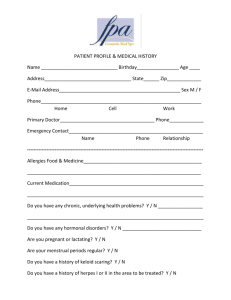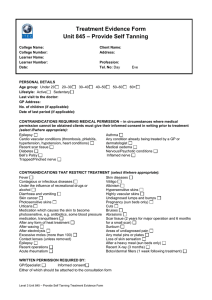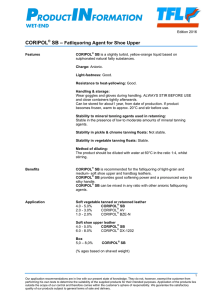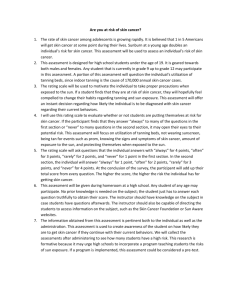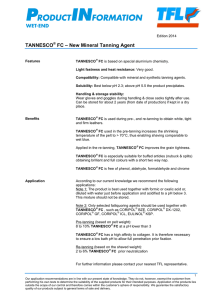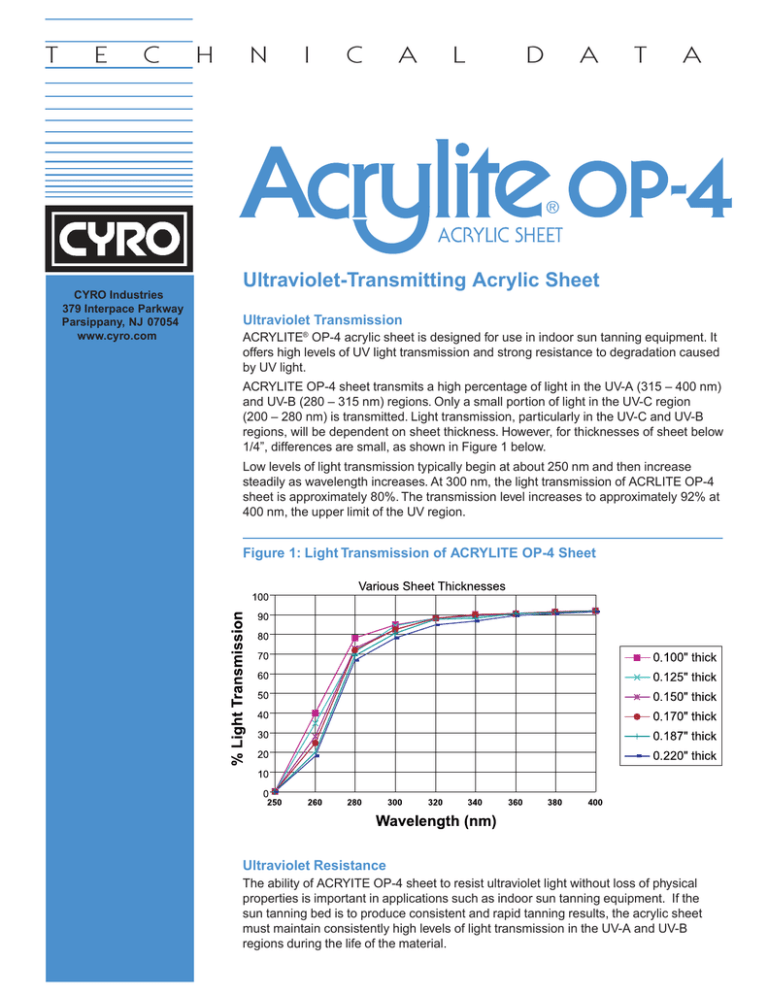
T
E
C
CYRO Industries
379 Interpace Parkway
Parsippany, NJ 07054
www.cyro.com
H
N
I
C
A
L
D
A
T
A
Ultraviolet-Transmitting Acrylic Sheet
Ultraviolet Transmission
ACRYLITE® OP-4 acrylic sheet is designed for use in indoor sun tanning equipment. It
offers high levels of UV light transmission and strong resistance to degradation caused
by UV light.
ACRYLITE OP-4 sheet transmits a high percentage of light in the UV-A (315 – 400 nm)
and UV-B (280 – 315 nm) regions. Only a small portion of light in the UV-C region
(200 – 280 nm) is transmitted. Light transmission, particularly in the UV-C and UV-B
regions, will be dependent on sheet thickness. However, for thicknesses of sheet below
1/4”, differences are small, as shown in Figure 1 below.
Low levels of light transmission typically begin at about 250 nm and then increase
steadily as wavelength increases. At 300 nm, the light transmission of ACRLITE OP-4
sheet is approximately 80%. The transmission level increases to approximately 92% at
400 nm, the upper limit of the UV region.
Figure 1: Light Transmission of ACRYLITE OP-4 Sheet
Ultraviolet Resistance
The ability of ACRYITE OP-4 sheet to resist ultraviolet light without loss of physical
properties is important in applications such as indoor sun tanning equipment. If the
sun tanning bed is to produce consistent and rapid tanning results, the acrylic sheet
must maintain consistently high levels of light transmission in the UV-A and UV-B
regions during the life of the material.
The light transmission of the acrylic sheet measured at 300
nm is a useful parameter for gauging a sheet’s performance
in sun tanning bed applications. Most commercial tanning
bulbs only emit a few percent of their total light energy in the
UV-B region (280 – 315 nm). However, UV-B light is
necessary to cause erythema, a slight reddening of the
skin, which is necessary to initiate the tanning process.
Without erythema the pigmentation process resulting in
tanning cannot begin. The pigmentation process is
subsequently caused by exposure to UV-A light. Because
UV-B exposure is needed before tanning can start, the light
transmission of the acrylic sheet at 300 nm can have a very
significant affect on the overall performance of a sun
tanning bed.
Figure 2: Light Transmission of ACRYLITE OP-4 Sheet Before and After Tanning Bulb Exposure
* Exposure to a GENESIS 170W VHO lamp from a distance of 1.25” with air temperature maintained at 80°F
Service Life
ACRYLITE OP-4 sheet stands up to various climate conditions. Natural UV light and high humidity will not harm it.
ACRYLITE OP-4 sheet can be expected to outlast other
acrylic materials due to its ability to maintain light
transmission and resist UV degradation. In Figure 2 above,
the light transmission of ACRYLITE OP-4 sheet is shown
before and after 10,000 hours of exposure to a sun tanning
bed bulb. The light transmission is nearly unchanged.
ACRYLITE OP-4 sheet comes with a limited 10,000 hour
warranty against loss of light transmission due to exposure
to sun tanning bulb radiation. For details, contact your local
Authorized Distributor or call CYRO Industries’ Technical
Service Department at (203) 795-6081.
When sheets are replaced, it is usually due to physical wear
or mechanical damage. Following proper care and cleaning
procedures will help to ensure maximum life of the sheet.
Cleaning
ACRYLITE OP-4 sheet is easy to clean. Clean with a soft
cloth or chamois and a solution of mild detergent and
lukewarm water.
ACRYLITE OP-4 sheet offers excellent resistance to
staining from dirt, bacteria, and perspiration.
NOTE: When cleaning, never use concentrated
disinfectants, solvents such as methyl alcohol or other
liquids containing alcohol. CYRO’s Technical Service
department can assist with the selection and evaluation of
compatible cleaning solutions.
2
Scratches can be removed by rubbing with a polishing
paste designed for use with acrylic or by using a solventfree car polish.
Safety
ACRYLITE OP-4 sheet is more impact resistant than glass.
If subjected to impact beyond the limit of its resistance, it
does not shatter into small slivers but, rather, breaks into
comparatively large pieces.
Comfort
ACRYLITE OP-4 sheet is comfortable and warm to the
touch, making it attractive to the tanning bed user.
Machining and Fabrication
Users can machine ACRYLITE OP-4 sheet with all the
same tools recommended for ACRYLITE® GP acrylic sheet.
As with ACRYLITE GP sheet fabrication, the masking
should remain in place as long as possible to avoid
scratching.
For general fabrication guidelines refer to our brochure,
Working with ACRYLITE® acrylic sheet, (#1084) or visit the
Techknowlogy Center at www.cyro.com.
Physical Properties
With the exception of its unique light transmission
properties, ACRYLITE OP-4 sheet has similar physical
properties to ACRYLITE GP sheet. Typical values are listed
on the next page.
Physical Properties of ACRYLITE OP-4 sheet
Property (a)
ASTM
Method
Typical Value
(0.25” Thickness) (b)
Mechanical
Specific Gravity
D 792
1.19
Tensile Strength
Elongation, Rupture
Modulus of EIasticity
D638
10,000 psi (69 M Pa)
4.2%
4000,000 psi (2800 M Pa)
Flexural Strength (Rupture)
Modulus of Elasticity
D 790
16,500 psi (114 M Pa)
475,000 psi (3300 M Pa)
Compressive Strength (Yield)
D 695
18,000 psi (124 M Pa)
Impact Strength
Izod Milled Notch
D 256
0.4 ft. Ibs/in. of notch
(21.6 J/m of notch)
Rockwell Hardness
D 785
M-94
Barcol Hardness
D 2583
49
Refractive Index
D 542
1.49
Light Transmission, Total
D 1003
92%
—
Less than 1%
—
300-350 °F (149-177°C)
D 648
192°F (89°C)
—
140°F (60°C)
Optical (Clear Material)
Haze
Thermal
Forming Temperature
Deflection Temperature under load, 264 psi
Maximum Recommended Continuous
Service Temperature
Coefficient of Linear Thermal Expansion
(c)
D 696
.000040 in/in/°F (.000072 in/in/°C)
Cenco-Fitch
1.3 BTU/(Hr) (Sq. Ft.) ((°F/in.)
.
(0.19 w/m K)
—
0.35 BTU/(lb.) (°F)
.
(1470J/Kg k)
D 149
430 volts/mil (17 KV/mm)
D 150
3.5
3.2
2.7
D 150
0.06
0.04
0.02
Volume Resistivity
D 257
1.6 x 10 ohm-cm
Surface Resistivity
D 257
1.9 x 10 ohms
D 570
0.2%
0.2%
0.0%
0.2%
0.0%
Coefficient of Thermal
Conductivity (k-Factor)
Specific Heat @ 77°F
Electrical
Dielectric Strength
Short Time (0.125"-thickness)
Dielectric Constant
60 Hertz
1,000 Hertz
1,000,000 Hertz
Dissipation Factor
60 Hertz
1,000 Hertz
1,000,000 Hertz
16
15
Water Absorption
24 hrs @73 °F
Weight Gain during Immersion
Soluble Matter Lost
Water Absorbed
Dimensional Change during Immersion
Long Term Water Absorption
Weight Gain during Immersion
7 days
14 days
21 days
35 days
48 days
D 570
Odor
—
Taste
—
NOTES: (a) Typical values; should not be used for specification purposes.
0.5%
0.6%
0.8%
1.0%
1.1%
None
None
(b) Values shown are for 0.250" thickness unless noted otherwise. Some values will change with thickness.
(c) It is recommended that temperatures not exceed 140°F for continuous service or 160°F for short, intermittent use.
3
Thermoforming
ACRYLITE OP-4 sheet can be thermoformed using the guidelines for ACRYLITE GP sheet.
Recommended forming temperature is 320°F. If the part is line bent, annealing at 180°F will provide
optimum strength and quality.
Cementing
ACRYLITE OP-4 sheet can be cemented using the same solvent cements, thickened cements or
two-part polymerizable cements used for ACRYLITE GP sheet. Contact CYRO’s Technical Center,
consult our publication Working with ACRYLITE acrylic sheet (#1084) or visit the Techknowlogy Center
at www.cyro.com for more information on recommended cements. Be sure to obtain a material safety
data sheet (MSDS) from the cement manufacturer and follow their recommendations.
Flammability
ACRYLITE OP-4 sheet is a combustible thermoplastic. Precautions should be taken to protect the material from flames and
high heat sources. The products of combustion are carbon dioxide and water, if sufficient air is present. However, in many
fires sufficient air will not be available and toxic carbon monoxide will be formed, as it will from other common combustible
materials. We urge good judgment in the use of this versatile material and recommend that building codes be followed
carefully to assure it is used properly.
Important Notice:
The information and statements herein are believed to be reliable but are not to be construed as a warranty or representation
for which we assume legal responsibility. Users should undertake sufficient verification and testing to determine the suitability
for their own particular purpose of any information or products referred to herein. NO WARRANTY OF FITNESS FOR A
PARTICULAR PURPOSE IS MADE. Nothing herein is to be taken as permission, inducement or recommendation to practice
any patented invention without a license.
We invite you to visit our TechKnowlogy
Center on www.cyro.com.
Visitors have immediate access to frequently asked
questions, technical concerns, physical properties,
processing conditions, fabrication tips, regulatory
compliance information, engineering guidelines,
tips for troubleshooting, and hundreds
of other facts about acrylics from one
of North America’s leading
manufacturers of acrylic-based
polymer and sheet products.
Technical Service
Sales Offices
For more information or
specific questions about
your project, contact
CYRO’s Technical Service
Representatives.
For the name of your local Authorized Distributor, visit
www.cyro.com or call 800-631-5384.
Eastern Region
CYRO Industries
25 Executive Blvd.
Orange, CT 06477
203-795-6081
CYRO Canada Inc.
6285 Northam Drive
Suite 100
Mississauga,
Ontario L4V 1X5
905-677-1388
800-268-4743
4
1354B-1001-5MG
© 2001 CYRO Industries. All Rights Reserved. Printed in USA.
CYRO Industries, Parsippany, New Jersey 07054

